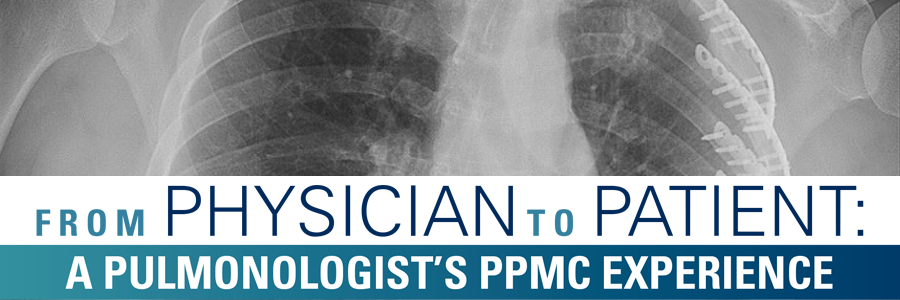
The old saying goes that doctors make the worst patients. After all, it can’t be easy switching from a supposedly indestructible, invulnerable paragon of health who has all the answers, to an overwhelmed patient who suddenly has to relinquish control and rely on the care of others. However, some physicians are able to bridge the gap and contribute to their care while also getting a crash course in the patient experience. Faisal Siddiqui, MD, MSc, a fellow in Pulmonary and Critical Care, can attest to that.
When Siddiqui was rushed to Penn Presbyterian Medical Center after a car accident left him and two of his brothers with “nasty” injuries, his background allowed him to make highly informed decisions about his treatment. His trust in his colleagues also made him comfortable stepping back – even when it became clear that a newer, challenging procedure would be required to get him on the road to recovery.
Faisal Siddiqui, MD, MSc, and his surgeon and colleague, Adam Shiroff, MD, FACS.
Adam Shiroff, MD, FACS, director of the Penn Center for Chest Trauma and an associate professor of Surgery who cared for Siddiqui and one of his brothers, noted that “75 percent of trauma deaths involve severe chest injuries” and that his definitely qualified as severe. Siddiqui is a bit more nonchalant about the crash and aftermath. “I sustained multiple rib fractures, and an X-ray showed a pneumothorax, or collapsed lung, under those fractures,” he said casually. “I also had blood pooling in my chest cavity, and they needed to make a pretty significant incision and insert chest tubes. It wasn’t great.”
The rib cage is made up of 12 paired rib bones. The upper seven pairs are directly attached to the sternum and are labeled “true” ribs, while ribs eight through 10, the “false” ribs, are attached indirectly to the sternum by pieces of cartilage that make up the costal wall. Ribs 11 and 12, which don’t attach to the sternum at all, are referred to as “floating” ribs. If these ribs are cracked or sustain a hairline fracture, the internal damage is minimal, but they can cause sharp chest pains and difficulty breathing. However, if larger or complex breaks leave jagged edges, they can cause damage to other organs, including puncturing a lung, as in Siddiqui’s case.
The treatment for broken ribs generally involves leaving them to heal on their own for four to six weeks with medication to lessen the pain exacerbated by breathing and coughing, but when multiple ribs have been fractured or broken in multiple places (“flail chest”), rib plating may be the better choice. This procedure involves making small, minimally invasive incisions, carefully parting the chest muscles, re-aligning the ribs, and then bridging the breaks with small titanium plates and screws similar to those used to treat broken arm and leg bones. While it’s hard to conduct randomized and controlled trials for procedures like this given the condition the patient, it has become more common over the past decade. It is championed as a best case treatment for a worst case injury by the Penn Center for Chest Trauma.
Though ribs are often left to mend themselves, Siddiqui’s post-op chest X-rays show the hardware that made his recovery smoother and less painful.
“Despite the growing literature supporting fixation of the badly injured chest wall, there are still those that question it, think of it as unnecessary, or haven’t seen the benefits firsthand like we have,” Shiroff said. “There hasn’t been a large, definitive trial, but the technology has outpaced the science in this case. The plating technique and our pain management strategies have evolved, so we can significantly shorten a patient’s recovery time and get them back on their feet without six weeks — or more — of discomfort.”
Knowing that early plate and screw fixation of multiple rib fractures improves patient outcomes, decreases lengths of stay, lowers complication rates (and potential dependence on pain medication), and could help Siddiqui return to his life and work more quickly, Shiroff suggested the procedure. Despite knowing it was “not the standard of care,” Siddiqui quickly agreed, noting, “In my condition, it offered the best possible chance for a positive and efficient outcome.”
Siddiqui’s surgery was a great success, and the pulmonologist-turned-patient never required a ventilator or experienced any breathing issues. Not long after the procedure, he was up and walking around, and after a week in the hospital, he was discharged and already on his way to a full recovery. Physical therapy has been helpful in healing his left shoulder muscles, and he no longer needed pain medication after a few short weeks.
“If you’re looking for the data that this type of intervention is the best, here it is! My brother and I both had this procedure done successfully, and two out of two cases support that complicated rib fractures warrant this type of care,” Siddiqui said. “I have nothing but praise for Adam and the surgical team’s quick thinking and excellent work. They made my time as a patient as comfortable as possible, and they really provided a great experience. And remember, this is coming from a pulmonologist! I’m so grateful for everything.”